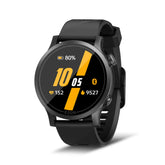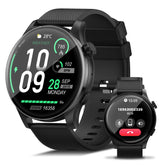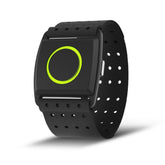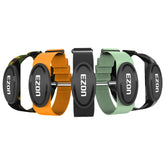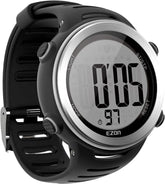Cycling Performance Hack: Heart Rate Monitors & Pacing for Long Rides
Unlock cycling efficiency and conquer century rides or mountain biking with data-driven strategies. This guide reveals how chest strap heart rate monitors and cycling-specific pacing watches optimize effort, prevent burnout, and boost performance on every terrain.
1. Heart Rate Zones: The Science of Sustainable Speed
A. Define Your Zones with a Chest Strap Monitor
- Chest Strap Accuracy: Unlike wrist-based monitors, chest straps (e.g., Polar H10) provide instant, motion-resistant heart rate data—critical for high-intensity efforts.
-
5 Key Zones for Cyclists:
Zone Intensity Purpose Example Ride 2 Easy Aerobic endurance (70–80% FTP) Century ride base training 3 Moderate Lactate threshold (80–90% FTP) Tempo climbs 4 Hard High-intensity intervals Mountain bike sprints
B. FTP (Functional Threshold Power) Basics
- How to Test: 20-minute all-out effort; FTP = 95% of average power/heart rate.
- Training Impact: Zone 3 rides at 88–94% FTP build sustainable race pace, tracked precisely by chest strap data.
2. Pacing Strategies for Every Ride Type
A. Century Rides (100+ Miles)
-
Pacing Plan:
- First 50 miles: Zone 2 (60–70% MHR) to conserve glycogen.
- Last 50 miles: Allow Zone 3 (70–80% MHR) for rolling hills, using a pacing watch to maintain even splits.
- Nutrition Sync: Program gel alerts (every 45 mins) to replace 60g carbs/hour, guided by heart rate-driven calorie burn data.
B. Mountain Biking: Terrain Adaptation
- Technical Sections: Dial back to Zone 2 on singletrack to preserve focus; surge to Zone 4 for short climbs (e.g., 1-minute efforts at 90% MHR).
- GPS Mapping: Use watch routes to pre-plan energy expenditure (e.g., “Steep climb at mile 12—save 10% effort”).
3. Training Plans for Peak Efficiency
A. 8-Week Century Ride Plan
Weeks 1–4: Base Building
-
Key Workouts:
- 3x/week Zone 2 rides (2–4 hours), focusing on smooth pedal strokes (cadence 85–95 RPM).
- 1x/week hill repeats (Zone 3) to build climbing resilience.
- Chest Strap Use: Ensure heart rate stays steady during long rides (±5 BPM variation).
Weeks 5–8: Intensity & Taper
-
Peak Week:
- 6-hour ride at Zone 2, practicing fueling and pacing with a pacing watch.
- Taper: Reduce mileage by 30%, maintain 1x/week Zone 4 intervals for speed.
B. Mountain Bike Specific Training
-
Skills + Strength:
- 2x/week technical trail rides, using heart rate data to avoid overtraining (keep weekly HRV above 50).
- 1x/week gym session (squats, core) to improve power-to-weight ratio.
4. Gear Up for Precision
A. Chest Strap Heart Rate Monitor Benefits
| Feature | Cycling Benefit | Top Pick |
|---|---|---|
| Real-Time Accuracy | Immediate feedback for interval training | Polar H10 (EZON compatible) |
| Water Resistance | Sweat-proof for long rides | Wahoo TICKR X |
B. Pacing Watch Must-Haves for Cyclists
| Feature | Long Ride Benefit | EZON Recommendation |
|---|---|---|
| Multi-Band GPS | Accurate route tracking in canyons | EZON GPS Series |
| Battery Life | 40+ hours for multi-day events | EZON Endurance Watch |
| Power Meter Sync | FTP-based training without extra devices | EZON Pro Cycling Watch |
C. Accessories
- Aero Helmet: Reduces drag by 10% at 25 mph—pair with watch aerodynamic data.
- Clip-In Pedals: Improve power transfer, tracked via cadence metrics.
5. Common Mistakes to Avoid
-
Ignoring Cadence for Heart Rate:
- Solution: Maintain 85–95 RPM in Zone 2 to reduce knee strain, even as heart rate rises on climbs.
-
Overusing Zone 4 on Long Rides:
- Solution: Limit high-intensity efforts to 10% of century rides; use chest strap data to recover fully between surges.
-
Neglecting Recovery Nutrition:
- Solution: Post-ride, consume 1g carbs/kg + 0.3g protein/kg within 30 mins, guided by watch’s calorie burn data.
6. Race-Day Execution
A. Pre-Ride Warm-Up
- 1-Hour Routine: 20 mins easy spin (Zone 1) + 10 mins Zone 3 accelerations to prime legs, monitored by chest strap.
B. Mid-Ride Adjustments
- Heat Management: If heart rate exceeds Zone 3 by 5 BPM on hot days, slow pace 5% and sip electrolytes.
- Drafting Strategy: Use watch pace alerts to maintain 25 km/h in a peloton, reducing energy expenditure by 20%.
7. FAQs: Your Cycling Data Questions Answered
Q: Should I use a chest strap and wrist monitor together?
- No need—chest straps are more accurate for cycling. Use wrist-based for daily activity tracking.
Q: How to pace if I don’t have a power meter?
- Rely on heart rate zones and perceived effort (RPE): Zone 2 = “comfortably hard” conversation pace.
Q: Can mountain biking improve road cycling performance?
- Yes! Technical terrain enhances leg speed and core stability, reflected in lower heart rate for the same road pace.
Ride Smarter, Ride Farther
With a chest strap heart rate monitor and pacing watch, every pedal stroke becomes a calculated step toward efficiency. Whether tackling a century ride or conquering mountain trails, let data guide your intensity, recovery, and nutrition.
Gear up with precision tools, train within your zones, and trust the process—your next PR or summit is within reach. Pedal with purpose, pace with confidence, and let technology be the hack that elevates your cycling to new heights.
EZON Watch: Professional sports technology brand
https://ezonwatch.com
https://ezonwatch.com
